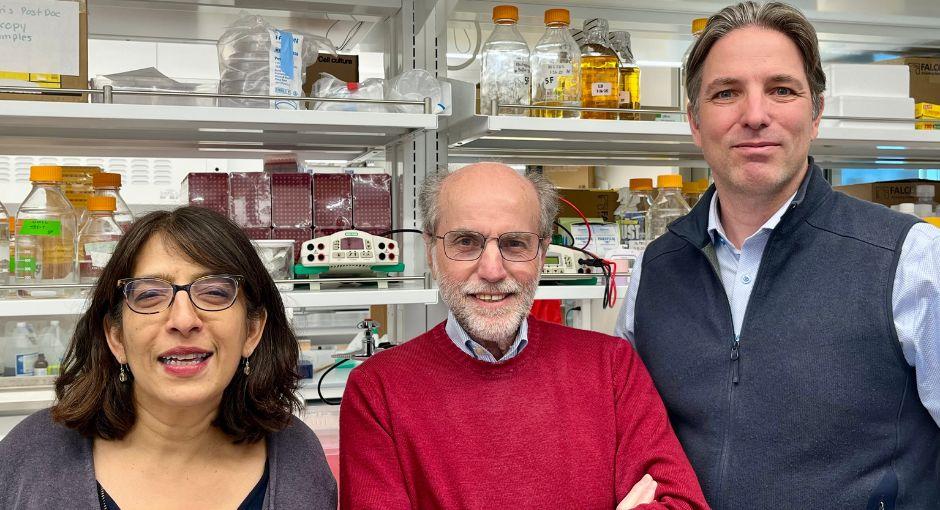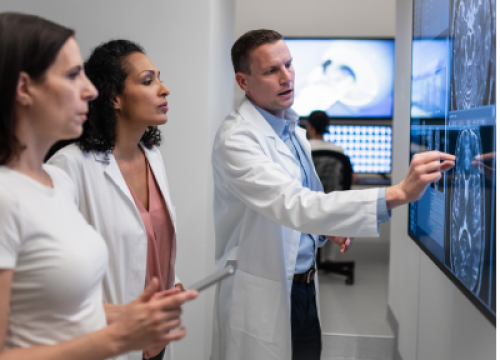From Parkinson’s Foundation Research Center to Powerhouse: How Yale Became a Leader in Parkinson’s Science

In a landmark investment to accelerate the path to a Parkinson’s disease (PD) cure, in 2019, the Parkinson’s Foundation awarded $8 million to establish four elite Parkinson’s Foundation Research Centers. Each one received $2 million over four years.
In this series of articles, we will share the story of each center — their goals, successes, surprises and the future of their PD research. In this article, we check in with the Parkinson’s Foundation Research Center at the Yale School of Medicine.
Research Centers
The Parkinson’s Foundation selected four centers for their groundbreaking potential to transform PD research. Together, they launched a series of innovative, interlinked studies aimed at deepening our understanding of PD and translating discoveries into real-world impact for people living with the disease.
Studies ranged from basic science (understanding the disease or how PD affects the brain) to applied science (solving real-life problems associated with PD) to clinical research in humans or a combination of these.
Before The Award
At first, despite housing many scientists and clinicians with interests in PD, Yale School of Medicine did not have a hub specifically focused on the molecular mechanisms causing the disease.
To fill this gap, in 2005 Yale established the Interdepartmental Program in Cellular Neuroscience, Neurodegeneration and Repair (CNNR), and began recruiting top researchers with diverse expertise and the shared goal of advancing the understanding of neurodegenerative diseases like Parkinson’s. The first recruited was Sreeganga Chandra, PhD, who had prior postdoctoral experience in PD research.
“Dr. Chandra played an important role in seeding and promoting interest in the cell biology of PD at Yale” said Pietro De Camilli, MD, a cellular neurobiologist and one of the two founding directors of the CNNR program.
At the time, Dr. De Camilli had no prior track record in PD research, but he soon discovered that two major proteins he was studying were products of two genes implicated in familial early-onset PD, leading him to realign his work around PD disease mechanisms.
Another investigator associated with the CNNR, Shawn Ferguson, PhD, also had never worked on PD, but was “an expert in the cell biology of lysosomes, a cell compartment whose importance in PD pathogenesis, and more generally in neurodegenerative diseases, was being increasingly recognized,” said Dr. De Camilli.
When the Parkinson’s Foundation announced its call for Research Center proposals, Dr. De Camilli invited colleagues Dr. Chandra and Dr. Ferguson to apply together. The idea of the team was to focus on a theme that had emerged in PD genetics and was relevant to each of their labs’ research: endolysosomal dysfunction.
Toward this aim, the team proposed original and high-impact projects. The Parkinson’s Foundation recognized their potential, awarding them Research Center funding to launch three major studies:
-
Understanding how the defect of a protein called auxilin may cause PD (Dr. Chandra)
-
Investigating the link between PD and lysosomes, the recycling stations of the cell (Dr. Ferguson)
-
Uncovering how dysfunction of lipids (fats)-building blocks of the walls of endolysosomal compartments may cause PD (Dr. De Camilli)
Cellular Processes Underlying PD
At a cellular level, there are two key problems that occur in PD. One is a drop in dopamine. This is the chemical signal that is used for communication between brain cells called neurons and, in turn, helps the body process movement and moods. The other problem is a buildup of a sticky protein called alpha-synuclein inside neurons.
Both issues are linked to defects in how cells manage their internal transport system. This is the complex movement of materials and nutrients through the cell’s “endolysosomal system.” The endolysomal system uses an intricate array of small containers called vesicles moving inside a cell to handle export, import, sorting, recycling and disposal functions.
To picture this, imagine each neuron as a small city that is in constant communication with other neurons. Each neuronal city depends on the export and import of shipments of supplies through communication centers with other neuronal cities called “synapses.” Cargo is sorted and loaded into the “vesicles,” shipping containers that carry materials where they are needed. There are major centers inside cells, called “endosomes,” where all the material is sorted. Some special cargo is imported into cells via locked containers called “clathrin-coated vesicles.” Once inside the city, these containers are “unlocked” by shedding their clathrin coat so their content can be delivered to endosomes.

After deliveries are made, the vesicles are reused to take any waste to the cell’s recycling center, called a “lysosome.” These lysosome recycling centers break down waste with enzymes and acid in compartments safely tucked away from the rest of the cell. In so doing, lysosomes liberate nutrients that can be used to build new cellular components. These processes collectively support the ability of neurons to communicate with each other while also preventing the accumulation of cellular trash (including alpha-synuclein buildup) and ensuring a supply of building materials to maintain neuronal health.
The three main research projects supported by the Research Center Award focus on understanding and fixing problems in these cellular transport and recycling systems — processes that are disrupted in Parkinson’s.
Unlocking the Connections Between Auxilin & PD: Dr. Chandra
Following the release of dopamine from one neuron to another, the vesicle containers used to deliver dopamine to the synapse need to be rebuilt. Neurons rebuild them using clathrin-coated vesicles, the cell's locked shipping containers. To unlock these containers, neurons use a special "key" protein called auxilin, which was the focus of Dr. Chandra’s research.
Mutations that cause auxilin defects are linked to early-onset PD, but how auxilin dysfunction contributes to the disease was poorly understood. Dr. Chandra and her team first characterized mice that lack auxilin to see if they were a good model for PD research.
Dr. Chandra said, "the mice lacking auxilin develop cardinal features of Parkinson’s disease: age-dependent motor deficits that are responsive to L-DOPA, the death of dopaminergic neurons in the substantia nigra, and alpha-synuclein pathology.”
Next, Dr. Chandra discovered that being unable to unlock the clathrin containers also impacted the neuron’s ability to rebuild packages containing dopamine. Imagine this as a cellular traffic jam, where the locked containers get stuck in transit. This prevents them from bringing in other materials, being unlocked and reused for a new shipment.
The shipment of dopamine, the key signal that declines in PD, was also impacted in this neuronal traffic jam. At the synapses, there were fewer containers for it to be loaded into and released for communication with other neurons. Finding a way to unlock containers and prevent traffic jams would be key to making dopamine more available and improving PD symptoms.
With that in mind, Dr. Chandra collaborated with Dalibor Sames, PhD, at Columbia University to test the effects of a repurposed drug called Ariadne on the auxilin-lacking mice.
They found that this drug had a remarkable impact on restoring balance and mobility in the mice, similar to levodopa. While there is still much more to learn about these drug effects, this collaborative research has brought to light Ariadne as a potential future treatment for people with PD, particularly those with auxilin mutations.
Understanding Links Between Disrupted Disposal of Cellular Waste & PD: Dr. Ferguson
Dr. Ferguson was new to PD research before his Research Center involvement. “This provided an opportunity for me to bring my research focused on the intersection between lysosomes and neurodegenerative diseases into the Parkinson’s field,” said Dr. Ferguson.
Lysosomes, the cell’s recycling centers, are managed by different genes and proteins. Dr. Ferguson hypothesized that the protein LRP10, which has documented mutations linked to familial PD, was a recycling facilitator. After investigating how cells behave when LRP10 is turned off, he and his research team found that LRP10 indeed plays a significant role in facilitating lysosome function.
Following the city metaphor, LRP10 helps navigate delivery containers to lysosomes, bringing in proteins that support lysosomal function. Without LRP10’s help, the cells’ ability to build working recycling centers is disrupted. In PD, when lysosomes don’t break down and recycle waste properly, proteins like alpha-synuclein build up. Alpha-synuclein forms toxic clumps that damage brain cells, leading to tremors, stiffness, and other movement and non-movement symptoms.
Dr. Ferguson and his team also developed mice with genetic mutations of LRP10 and looked at how their brains were affected. They found that the loss of LRP10 impacts a specific type of cell in the brain, called microglia, which protect neurons. Dr. Ferguson also uncovered links between microglia and one of the most well-known PD genes LRRK2, revealing new roles for LRRK2 in regulating lysosomes in microglia that were never known before.
The success and breakthroughs from this project have shifted the focus of Dr. Ferguson’s career to PD.
“This Research Center Award was the gateway for my entry into the Parkinson’s disease field and was thus a catalyst that fueled a much broader Parkinson’s program. I am also committed to recruiting additional colleagues with complementary skills into the PD field to increase our collective chances to make the discoveries necessary to end this disease.” - Dr. Ferguson
Connecting lipid dynamics in the endolysosomal system & PD: Dr. De Camilli
“My interest in PD was sparked by the finding that two proteins studied in our lab were identified by human genetic studies as PD proteins,” said Dr. De Camilli, referring to synaptojanin 1 (Synj1, also known by the name PARK20) and VPS13C (also known as PARK23). Both proteins regulate lipids (fats) - building blocks of the walls of different compartments of the endolysosomal system.
These two proteins function at different steps in the cell’s endolysosomal transport system and link Dr. De Camilli’s research directly to his colleagues: Synj1 is a functional partner with Dr. Chandra’s auxilin at the earliest step (clathrin-coated vesicles), and VPS13C is involved with Dr. Ferguson’s lysosomes (the latest step).
Dr. De Camilli and his team discovered that Synj1 is required to begin the unlocking process of clathrin containers after they are imported by modifying the lipids they are made of. In mice with Synj1 mutations, they observed PD-like symptoms.
Working with Dr. Chandra’s lab, they also found that mice with both auxilin and Synj1 mutations have significantly more issues, highlighting that the two proteins have important, cooperative roles in cells. Ongoing work from both researchers is investigating this overlap further.
Dr. De Camilli’s lab also learned that the protein VPS13C, a lipid transport protein, has an important role in repairing damaged lysosomes. As a lysosome is used heavily in recycling, its walls can begin to break down, threatening to leak toxic enzymes and acids into the cell, VPS13C helps bring the lipids needed to rebuild the walls. Most interestingly, in collaboration with Dr. Ferguson, they found that the PD protein LRRK2 works in tandem with VPS13C in lysosome repair, a new discovery.
Understanding how PD mutations affect neuronal function is crucial in designing new PD treatments.
Dr. De Camilli is now highly committed to continue his studies of PD. “In my own lab, I will continue to expand my research on how mutations in Synj1 and VPS13C result in PD. We are very excited for being part of this new era of PD research.”
Building Collaborations as a Parkinson’s Foundation Research Center
Being a Parkinson’s Foundation Research Center not only supported these three main projects but also inspired the growth of PD research across Yale.
The groundbreaking research of the Yale Research Center team motivated other Yale researchers to explore how their own work could contribute to the understanding of PD. This award's dedicated funding for additional pilot projects allowed those researchers to join the PD field for the first time.
“We have awarded pilot projects to four principal investigators who had never worked on PD, and three of them have continued to work on this disease and are now involved in long-term collaborations with our groups,” said Dr. De Camilli.
“The momentum and enthusiasm for PD research at Yale led to support from numerous other funders devoted to PD scientific breakthroughs, such as Aligning Science Across Parkinson’s (ASAP), the Michael J. Fox Foundation, the Chan Zuckerberg Initiative, the Bumpus Foundation and the McKnight Foundation,” said Dr. Chandra.
This support led to new academic collaborations and joint publications as well, “connecting us to the PD community at large across different institutions in the US and abroad,” said Dr. De Camilli.
What began as three PD experimental proposals being accepted as a Parkinson’s Foundation Research Center has evolved into Yale becoming a nationally recognized hub for PD research.
“Beyond our individual projects, the Parkinson’s disease research community at Yale has grown dramatically over the past five years,” said Dr. Ferguson.
While the Research Center designation has concluded, its impact on the Yale School of Medicine and the scientists investigating PD remains, moving the institution and the greater PD research world toward future new treatments and, someday, a cure.
Learn More
The Parkinson’s Foundation works to improve care for people with PD and advance research toward a cure. Learn more with these resources:
-
Discover how we are working to close gaps in knowledge about PD: Advancing Research
-
Learn about and enroll in PD GENEration — a global genetics study that provides genetic testing and counseling at no cost for people with Parkinson’s.
-
Explore ways to get involved in the Parkinson’s Foundation — from becoming a research advocate to joining a research study.
Related Blog Posts

Neuro Talk: Newly Diagnosed

Meet a Researcher Working to Make Adaptive DBS More Effective
